Before the American Revolution, New York had more enslaved Africans – its most valuable commodity – than any other colony in the North. There were also free Africans, some descended from those freed by the Dutch West India Company. Men cleared farmland, filled swamps, and built structures and roads like Broadway and The Wall (today’s Wall Street). Women sewed, cooked, harvested, and cared for owners’ children as well as their own. From an early age, children carried water and firewood. The work was hard and death rates for Africans were disproportionately high. – National Park Service / US Department of the Interior
Between 1690-1794, approximately 15,000 enslaved and free Africans were buried in a 6.6-acre plot in Lower Manhattan near what is now Duane and Elk Streets. The area was identified on maps of the time as the Negros Burial Ground.
In 1991, an archeological team that was field-testing a construction site in Lower Manhattan (a requirement on any project which uses public funds that may have the potential to impact historic resources) made a surprising discovery – skeletal remains 24 feet below ground.
They stopped excavation when it was determined that the remains were from the Negros Burial Ground. In all 419 bodies of men, women and children were unearthed. Bone fragments and other items uncovered at the site were sent to Howard University for examination.
The remains held a compelling narrative about the life of New York City’s African population. It showed that many were malnourished, suffered from delayed bone development and recurrent illnesses. Nine percent of those buried at the site were children 2 years of age and younger.
Many of the dead were adorned with beads, which were culturally significant, and shells that were believed to “enclose the soul’s immortal presence.” Some had their eyes covered with coins.
At first, the government wanted to exhume and preserve the remains and continue construction of the 34-story Ted Weiss federal building but the community was outraged. Months of protests led to an agreement. A third of an acre of the site was set aside for a memorial.
In 1993, the African Burial Ground was designated a National Historic Landmark, and a National Monument in 2006. In 2003, the remains were reinterred in seven raised mounds at the site.
A memorial, which was designed by Rodney Léon was completed in 2007. It features a sunken Libation Court, a gathering space for cultural ceremonies, and is surrounded by a Circle of the Diaspora that is inscribed with signs, symbols, and images from the African Diaspora.
There’s also an Ancestral Chamber that provides sacred space for contemplation, and a Wall of Remembrance that describes events that contributed to the creation of the African Burial Ground. The location where the remains were reburied are marked by Ancestral Pillars.

A visitor center, which is located on the ground floor of the Weiss Building, features a permanent exhibition which tells the story of the lives of Africans in New York through photos, scrapbooks and installations. Life-size and lifelike sculptures of men and women gathered around a coffin is the centerpiece of the exhibition.
African Burial Ground National Memorial Particulars
The African Burial Ground Memorial site, which is at the corner of Duane and Elk Streets, is closed during the winter. However, the African Burial Ground Visitor Center, located around at 290 Broadway at Duane Street is open Tuesday-Saturday 10:00 a.m. to 4:00 p.m. Admission is free, but donations are accepted.
Further Reading:
Gotham: A History of New York City to 1898 [simpleazon-image align=”center” asin=”0195140494″ locale=”us” height=”160″ src=”http://ecx.images-amazon.com/images/I/51A0v0-vafL._SL160_.jpg” width=”108″]
Linking up this week with Nancie’s Travel Photo Thursday at Budget Travelers Sandbox.

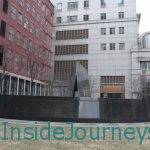
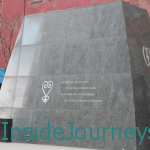
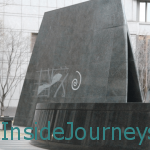
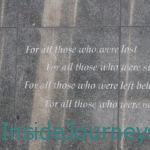
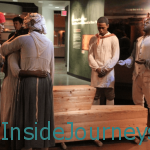
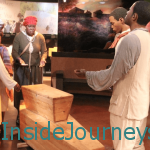
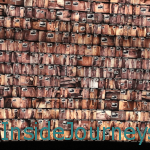
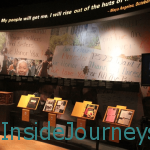

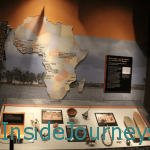








Interesting memorial…
Thanks, Lili!
In my ignorance I don’t associate slavery and mass death with New York at all, only the south. This looks like a fascinating museum, and one that should be more well-known. Thanks for writing about it.
A very moving post, Marcia, the place brings history to life. Thank God at least some land was set aside for the memorial.
Such a sad history – and an unbelievably bleak life for so many African people. This memorial sounds like an illuminating & interesting spot to visit.
What an amazing discovery and now a place to visit and remember. Thanks for taking us there.
You’re welcome, Jan. A very amazing discovery for sure.
It is sad and definitely illuminating, Leigh. Had they not happened on this, a lot of people – including me – wouldn’t have known about the ill effect of that kind of backbreaking work on the body.
Thanks, Rachel. When you think about it, it really was the least they could do given the publicity and attention the find received.
Most people do make that connection, Phoebe, but that’s because of the Civil War when the north became synonymous with freedom.
I love this post. Very true and interesting. Thanks for sharing the history.
That is so interesting – fantastic story. Burial grounds can really tell us a lot about day to day life in times past, but this one is especially poignant.
I somehow didn’t realize that slavery started so early in the USA and that it was that large in New York. I’m glad that the field-testing requirement is in place as I would think that there would be much to uncover in a city as old as New York. The memorial and visitors center seem like a good way to educate the public and honor the slaves buried there.
A moving place, a bit dark for the history perhaps, but it’s kind of nice to know that there is a place for remembrance. Thank you Marcia for taking us there, beautiful pictures, all of them. I loved the inscription on the monument in particular, details the place simply so beautifully.
A moving place, a bit dark for the history perhaps, but it’s kind of wonderful to know that there is a place for remembrance. Thank you Marcia for taking us there, beautiful pictures, all of them. I loved the inscription on the monument in particular, details the place simply beautifully.
Hi Marcia, I’m guilty of not visiting this museum yet but you just gave me the nudge. Just seeing the museum through your post is already moving. A lot of people don’t normally associate New York with slavery so this museum is a real eye opener. I’m happy they built this wonderful memorial because those people buried there deserve it and their stories need to be heard.
I have seen the National Monument in a park listing but never would have expected it to be in NYC. What an amazing discovery and I’m so glad this was set aside for everyone to visit and learn. It’s so sad that some of them were infants. I need to add this to my NYC places to visit next time. Thanks for the inspiration, Marcia.
I had no idea that New York’s history so entwined with slavery. This looks like a lovely memorial, and one I will visit when I get back to New York. Thanks for linking up to Travel Photo Thursday this week!
Such a sad history and such challenging conditions it must have been for the African community. A really moving post Marcia.
Thanks, Arti. It was a sad phase of history for sure but I’m glad that there’s something there to remind us of it.
You’re welcome, Nancie!
Yes, it’s funny how that happened but New York was heavily involved in slavery. I hope you do get to visit next time you’re here.
It is part of the Park Service and if you have that little passport, they stamp it for you.
Hope you get it see it next time you’re in NY, Mary.
Marisol, you know what it’s like when something’s in your backyard — it’s ignored until friends visit. I’ve known about this museum for a while but I knew it’d stir my emotions so I kept putting it off. I’m glad I finally went, it was really worth it.
Plan to go when the memorial is open so you get to see it up close.
You’re welcome, Ben. Thanks for stopping by and commenting.
It surprised me too, Michele. The south was always connected in my mind, not the north and certainly not New York.
They do hold a lot of stories for sure, Seana. This one particularly.
Looking forward to reading more. Great blog post.Truly looking forward to find out more.
Thanks for the visit and your comment, Des.
Hope you do find out more.
So glad you wrote about this, I’ve heard snippets about it but never been! It sounds like a wonderful and very informative memorial, and I now have it on my “list of NY places to visit”. Thanks Marcia!
You’re welcome, Jess. It was on my list for a while too — it’s well worth it.
Like many others here, I haven’t associated slavery with New York, so very interesting to learn. A very touching memorial this.
Hello Marcia Mayne,
I am so happy to read this article on your blog “Inside Journeys”. I want to make strong relationship with your blog as a reader so I have subscriber it.
~Diana
Thanks for your comment, Diana. If you haven’t visited the Memorial, I hope you get a chance to soon.
African Burial Ground National Monument, NYC seem to be a nice getaway place. I wanna travel there and enjoy the great things to see.